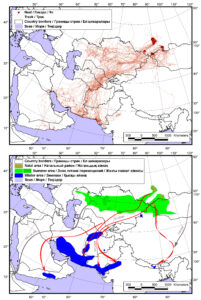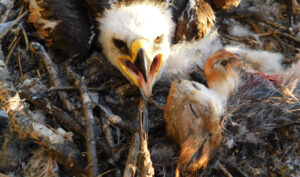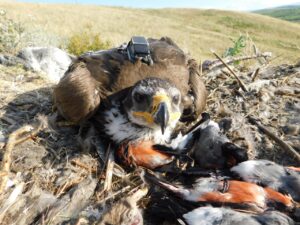Third International Scientific and Practical Conference “Eagles of the Palearctic: Study and Conservation”
Raptors Conservation. Suppl. 2. Proceedings of Conferences
Steppe Eagle in the Altai-Sayan Region – research results 2019–2023
Karyakin I.V., Nikolenko E.G., Shnayder E.P. (Russian Raptor Research and Conservation Network; Sibecocenter LLC, Novosibirsk, Russia)
Contact:
Igor Karyakin ikar_research@mail.ru
Elvira Nikolenko elviranikolenko@gmail.com
Elena Shnayder equ001@gmail.com
Recommended citation: Karyakin I.V., Nikolenko E.G., Shnayder E.P. Steppe Eagle in the Altai-Sayan Region – research results 2019–2023. – Raptors Conservation. 2023. S2: 233–241. DOI: 10.19074/1814-8654-2023-2-233-241 URL: http://rrrcn.ru/en/archives/35043
According to the Red List of IUCN, Steppe Eagle (Aquila nipalensis) is a globally Endangered (EN) species, included in the Red Data Book of Russia and protected throughout the country. Steppe Eagle breeding range in Russia covers semi-desert and steppe areas from Kalmykia in the west to Dauria in the east. The Altai-Sayan Ecoregion (ASER) is key for Steppe Eagle: about half of the entire breeding population of the species in Russia is concentrated here. Therefore, monitoring Altai-Sayan Steppe Eagle breeding groups is very important.
In ASER Steppe Egle nests in steppe basins, except for Kuznetsk, including narrow steppe valleys of the Chuya and Katun rivers in Central Altai, as well as in the highlands of Southeastern Altai, partly Tanu-Ola and Western Sayan, including the high-mountain Ukok plateau. The total number of the species nesting in the ASER, considering the foothills of Altai Territory, in 2018 was estimated at 1400–1800 pairs. Currently population does not show a fundamental change, despite various negative and positive dynamics in different ASER breeding groups. By 2022, 756 eagle breeding territories have been identified in the region, which is 47.25% of the estimated species population. About 50% of favorable Steppe Eagle habitats identified during GIS modeling are not covered by survey, although nesting of the species was established in all clusters of modeled habitats during irregular visits. Thus, we know the entire Steppe Eagle breeding range in ASER, including areas where isolated pairs breed in suboptimal conditions. Annual monitoring is carried out in 68 Steppe Eagle breeding territories, which is 9% of the known breeding territories; over a three-year period, 256 breeding territories (33.9%) were monitored, over five years – 312 (41.3%). We regularly monitor breeding groups in the most problematic areas in terms of anthropogenic influence, and in those less impacted by human economic activity: on the left bank of Tes River in the Ubsunur basin, on the TanuOla ridge, in Tuva basin of the Republic of Tyva, in Minusinsk Basin in the Republic of Khakassia and the Krasnoyarsk Territory, on the periphery of the Chui steppe, on the Sailyugem ridge and Ust-Kan basin of the Altai Republic, and in the foothills of Altai within the Altai Territory. Ukok and Southwestern Tyva where main Steppe Eagle breeding groups are less susceptible to anthropogenic factors have not been visited in recent years.
Diet analysis showed that Steppe Eagles are quite flexible in managing prey resources and using a wide food range, both typical steppe and intrazonal species, diurnal and nocturnal (the latter are represented mainly by roadkill: Jerboas, Hedgehogs, and other species). In particular, eagles nesting in steppe and highlands above forests have such species as Squirrels (Sciurus vulgaris), Woodpeckers (Picidae sp.), and Bullfinches (Pyrrhula pyrrhula), possibly picked up from roads as well. As eagles most often nest within sight of farms and roads, eagles regularly use them to obtain food, picking up animals that that have died due to various reasons. It increases the threat of poisoning, collision with vehicles, or shooting. Despite the plasticity of Steppe Eagle hunting behaviour, they are closely connected to the mass colonial burrowing rodents (mainly Ground Squirrels Spermophilus sp.) and Pikas (Ochotona sp.), and high abundance and/or availability of these species in the spring determine both nest occupation and breeding success. If the spring abundance or availability (due to late spring) of basic food items is insufficient, Steppe Eagles do not begin to breed, and in half of the cases leave their breeding territories by mid-summer.
Recently we have begun to study Steppe Eagle migration and philopatry not only by ringing, but using transmitters too, in addition to classical monitoring of breeding groups and control of breeding territories occupancy, partner change using photo and video observation of nests, molecular methods, breeding success, productivity, diet.
In order to study migrations, 30 Steppe Eagles were tagged with transmitters (Aquila – 22 ind., Druid – 5 ind., Ecotone – 2 ind., GPS-Collars – 1 ind.). Tracking showed that most juvenile birds migrate in the western Circum-Himalayan Corridor, bypassing the high mountains of Central Asia. Only two birds migrated south through Tibet, and both died (one bird crossed the Himalayas but died in Nepal during the winter). Most eagles do not return to natal region in the first year, but wander during their first summer in Kazakhstan, and therefore this country plays a key role in the viability of the Altai-Sayan Steppe Eagle breeding groups. Visits to natal areas are observed from the second to third summer, and during fourth summer eagles begin to select territories and form pairs. Of the five eagles tagged with transmitters (one female and four males) whose home territories were visited during the fourth summer, four males had partners and nest outlines in chosen breeding territories, but only one male bred successfully (female did not have a partner and roamed widely). All eagles returned to their natal region for the summer by sexual maturity and occupied areas no further than 50 km (3, 36, 43 and 50 km) from nests in which they were born.
Reproduction of a pair lasts four years on average in control areas, meaning that every four years reproduction is paused for one to four years due to death of one of the partners. It is noteworthy that out of five fledglings tagged with transmitters and returned to the natal region by puberty, not one of them found their parents alive – all parents died during this period and were replaced by young eagles. Over a five-year period, the loss of breeding territories where pairs disbanded was compensated by the formation of new territories by younger birds in almost all control areas. The exception is Sailyugem ridge in the Altai Republic, where anti-plague service carried out the so-called village deratization outside populated areas (on outposts and farms), which led to loss of 30% of nesting pairs in the local Steppe Eagle breeding group due to poisoning with anticoagulants (half of them have not yet recovered). An increase in the Steppe Eagle abundance was noted in Khakassia – by 7.14% between 2011 and 2018, which was initially associated with redistribution of Steppe Eagle breeding pairs to abandoned Eastern Imperial Eagle (Aquila heliaca) territories, but recalculation of accounting indicators for all Khakass territories showed the remaining real increase in the species abundance. However, in 2019–2022, this increase was reversed (-3.16% of the 2018 estimate) due to displacement of Steppe Eagles from breeding territories by Golden Eagles (Aquila chrysaetos) and the dissolution of some pairs for unknown reasons. In the Republic of Tyva, Steppe Eagle abundance has been methodically restoring in 2008–2018 after a decline due to poisoning with bromadialone in Mongolia in 2001– 2002. By 2013, Steppe Eagle abundance in Tyva was estimated at 300–400 breeding pairs (Karyakin, 2013; Nikolenko, Karyakin, 2013), by 2019 – at 311–422 pairs. It was suggested that by 2020 Steppe Eagle would have fully recovered its abundance in Tyva to the 2000 estimate of 373–453 pairs (Karyakin et al., 2018; 2019). However, it did not happen, and the abundance have stabilized at 305–410 pairs. Even though Steppe Eagle began to occupy artificial forest plantations and nest in trees and threat of mortality on power lines in Tyva has been almost completely eliminated in recent years, restoration of the former Steppe Eagle breeding territories has slowed down for a number of reasons: an increase in the number of summer livestock stops in suitable habitats (because of government subsidies), the climate factor (fully feathered nestlings die in thunderstorms with hail, which became regular in July, and excessive moisture leads to intense vegetation, making prey and fledglings die of hunger), local residents killing eagles on purpose (shooting at nests) or accidentally (death under car wheels), and predation by herding dogs. At the same time, Steppe Eagle abundance has remained stable in the highlands of TanuOla during these years.
Despite a certain influence of local negative factors on the Altai-Sayan Steppe Eagle breeding groups, the main reason for the frequent dissolution of pairs lies outside the breeding range. We assume that the main contributor to such a short eagle life expectancy is poisoning in wintering grounds. It is already known that Steppe Eagles form aggregations in landfills and cattle burials, where they can accumulate various toxic substances, from non-steroidal anti-inflammatory drugs to anticoagulants and heavy metals. But so far chemical contamination of the species has not been studied at all. Another problem for at least some eagles flying to wintering grounds in India is the increasing mortality observed in eagles that were ringed and tagged with transmitters due to avian botulism, which is increasingly occurring on the salt lakes and sores of Northwest India. More than 23,500 birds died from avian botulism in 2019 on the lake Sambar and its vicinity (in Jaipur and Nagaur districts) in Rajasthan (Singh, Sen, 2023). Steppe Eagle fed on bird remains and died as well. This major isaster has received publicity, but eagle death on the smaller scale occurs regularly and is growing every year. Botulism outbreaks are likely to become more frequent as climate change alters wetland conditions in favor of the pathogen, as seen in large salt water bodies of Kutch in Gujarat and Sambar in Rajasthan. If the situation does not change, these areas may become “ecological traps” for Steppe Eagle.
Considering the enormous mortality of adult birds, which occurs mainly outside of the ASER, it is necessary to understand its causes. Since we assume the leading role of poisoning in Steppe Eagle mortality, further studies of chemical contamination of birds and clarification of their immune status regarding botulism is urgently needed.

Fig. 1. Movements of 30 eagles tagged with transmitters in 2013–2022 – at the top, their summering and wintering zones drawn based on tracks, and main migration routes. Despite the fact that most juvenile Steppe Eagles from the Altai-Sayan region spend the summer in Western Kazakhstan, on autumn migration they do not fly the main route of eagles from the Western Kazakhstan population through Ustyurt, but head to the southeast, joining the flow of eagles moving in Western Circum-Himalayan migration corridor.

Remains of the Squirrel (Sciurus vulgaris) in the nest of the Steppe Eagle (Aquila nipalensis). Photo by I. Karyakin.

